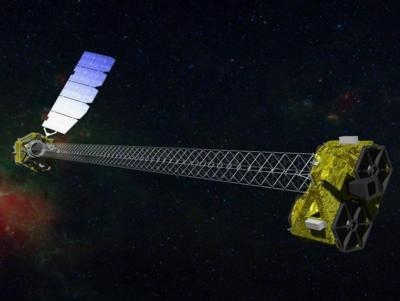Three Astrophysics Small Explorer Missions And Two Explorer Missions Of Opportunity To Receive Funding
NASA has selected five proposals submitted to its Explorers Program to conduct focused scientific investigations and develop instruments that fill the scientific gaps between the agency’s larger missions.

The selected proposals, three Astrophysics Small Explorer missions and two Explorer Missions of Opportunity, will study polarized X-ray emissions from neutron star-black hole binary systems, the exponential expansion of space in the early universe, galaxies in the early universe, and star formation in our Milky Way galaxy.
“The Explorers Program brings out some of the most creative ideas for missions to help unravel the mysteries of the Universe,” said John Grunsfeld, NASA’s Associate Administrator for Science at NASA Headquarters, in Washington. “The program has resulted in great missions that have returned transformational science, and these selections promise to continue that tradition.”
The proposals were selected based on potential science value and feasibility of development plans. One of each mission type will be selected by 2017, after concept studies and detailed evaluations, to proceed with construction and launch, the earliest of which could be launched by 2020. Small Explorer mission costs are capped at $125 million each, excluding the launch vehicle, and Mission of Opportunity costs are capped at $65 million each.
Each Astrophysics Small Explorer mission will receive $1 million to conduct an 11-month mission concept study. The selected proposals are:
SPHEREx: An All-Sky Near-Infrared Spectral Survey. James Bock, principal investigator at the California Institute of Technology in Pasadena, California.
SPHEREx will perform an all-sky near infrared spectral survey to probe the origin of our Universe; explore the origin and evolution of galaxies, and explore whether planets around other stars could harbor life.
Imaging X-ray Polarimetry Explorer (IXPE). Martin Weisskopf, principal investigator at NASA’s Marshall Space Flight Center in Huntsville, Alabama.
IXPE uses X-ray polarimetry, which is the measurement and interpretation of the polarization of electromagnetic waves, to improve our understanding of how X-ray emission is produced in objects such as neutron stars, pulsar wind nebulae, and stellar and supermassive black holes.
Polarimeter for Relativistic Astrophysical X-ray Sources (PRAXyS). Keith Jahoda, principal investigator at NASA’s Goddard Space Flight Center in Greenbelt, Maryland.
PRAXyS uses X-ray polarimetry to characterize the geometry and behavior of X-ray sources including super-massive black holes, pulsars, magnetars and supernovae.
Missions of Opportunity will receive $250,000 to conduct an eleven-month implementation concept study. The selected proposals are:
GUSTO: Gal/Xgal U/LDB Spectroscopic/Stratospheric THz Observatory. Christopher Walker, principal investigator at the University of Arizona in Tucson.
GUSTO is a balloon-borne observatory of high-frequency radio emissions from our Milky Way galaxy and a nearby companion galaxy, the Large Magellanic Cloud, to study the life cycle of interstellar material.
U.S. Participation in the LiteBIRD Cosmic Microwave Background Polarization Survey. Adrian Lee, principal investigator at the University of California in Berkeley.
The Japanese LiteBIRD mission with U.S. contributions to the payload will map polarized fluctuations in the Cosmic Microwave Background, or the leftover thermal radiation from the Big Bang, to search for the signature of gravitational waves from inflation, potentially shedding light on the universe a fraction of a second after the Big Bang.
The Explorers Program is the oldest continuous NASA program designed to provide frequent, low-cost access to space using principal investigator-led space science investigations relevant to the Science Mission Directorate’s astrophysics and heliophysics programs. Since the Explorer 1 launch in 1958, which discovered the Earth’s radiation belts, the Explorers Program has launched more than 90 missions, including the Uhuru and Cosmic Background Explorer (COBE) missions that led to Nobel prizes for their investigators.
The program is managed by Goddard for NASA's Science Mission Directorate, which conducts a wide variety of research and scientific exploration programs for Earth studies, space weather, the solar system and universe.
(Image provided by NASA. The Nuclear Spectroscopic Telescope Array (NuSTAR), launched in 2012, is an Explorer mission that allows astronomers to study the universe in high energy X-rays)
 ANN's Daily Aero-Term (04.24.24): Runway Lead-in Light System
ANN's Daily Aero-Term (04.24.24): Runway Lead-in Light System ANN's Daily Aero-Linx (04.24.24)
ANN's Daily Aero-Linx (04.24.24) Aero-FAQ: Dave Juwel's Aviation Marketing Stories -- ITBOA BNITBOB
Aero-FAQ: Dave Juwel's Aviation Marketing Stories -- ITBOA BNITBOB Classic Aero-TV: Best Seat in The House -- 'Inside' The AeroShell Aerobatic Team
Classic Aero-TV: Best Seat in The House -- 'Inside' The AeroShell Aerobatic Team Airborne Affordable Flyers 04.18.24: CarbonCub UL, Fisher, Affordable Flyer Expo
Airborne Affordable Flyers 04.18.24: CarbonCub UL, Fisher, Affordable Flyer Expo



